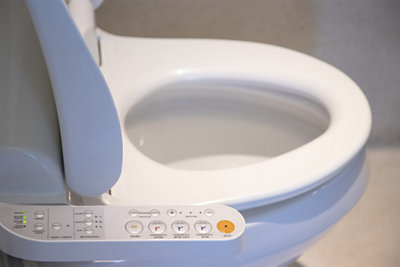Squeaky Clean & Feelin' Fresh: A Guide to Bidet Installation
In Japan, around 80% of modern households embrace bidets, a trend spreading globally. But what exactly is a bidet, and why consider installation? Beyond hygiene, bidets offer sustainability, ease of use, and sanitation. Curious about bidets? Read on for a complete guide, covering types, installation, and when to seek professional assistance.
What Is a Bidet?
A bidet is a sanitary device integrated into or as a standalone fixture in your bathroom. Functioning similarly to toilet paper but considered more sustainable, a bidet uses pressurized water to cleanse after using the restroom. Connected to the toilet's water supply, bidets provide a fresh and adjustable water stream.
A bidet, to put it simply, uses pressurized water to clean your bottom after you use the restroom. The water is fresh and clean, and you can alter the pressure to your preference.
Since bidets hook up to your toilet's water supply to always draw fresh water, they increase how much water your toilet will use. However, this is a relatively minor amount of water.
Why Install a Bidet?
One of the biggest benefits of a bidet is the heightened sustainability. By using a bidet, you'll cut down drastically on the amount of toilet paper you use.
Bidets use a small amount of water, making the amount they use almost marginal. The money you save and the lessened environmental impact from cutting down on toilet paper will cover this issue.
Another great reason for using bidets is better sanitation. Your hands will stay cleaner without wadding up toilet paper for wiping. Needless to say, the rest of you will stay cleaner as well.
In addition, bidets are great for accessibility. People who don't have full use of their hands may struggle with cleanliness in the restroom. They prove invaluable for individuals with limited hand mobility or injuries.
Some people may still want to use toilet paper for drying. Others may feel unclean if they don't use at least a small amount of toilet paper. So you may still want to keep toilet paper around for guests, as not everyone is comfortable using a bidet.
Choosing the Right Bidet for Your Bathroom
How do you know what sort of bidet to install? We'll get into some of the different types in a moment, but knowing the restrictions is crucial. Here are the main ways to know what bidet to install.
1. Space
Some restrooms will have space restrictions that will limit what you can install. The most common restriction is how much room is around the toilet bowl.
Some will use thick mounting bolts or larger bidet toilet seats. These can make installing a bidet seat tough in cramped areas.
Areas with more room are free to install any sort of bidet they like. The most important point of access is the water supply hose for the toilet. Make sure you have the room necessary to connect the water supply before beginning installation.
2. Budget
Another important factor to consider is what budget you're operating with. Your bidet installation can depend on what you can afford at the time.
There are several things to keep in mind when thinking of the budget for installing a bidet toilet. One factor is that you'll save money in the long run with the money you're keeping from buying toilet paper.
Another is what sort of bidet is most expensive. You can use your existing toilet seat instead of installing a bidet seat, for example.
It's also crucial to know what professionals will charge for their help. At Parker & Sons, we specialize in helping you improve your home without inflating your budget.
3. Features
Finally, what features are you looking for? Bidets can range from simple to luxurious, and the budgets will change accordingly.
Some will dispense water automatically when you flush the toilet. Other bidet attachment systems will have more customizable options, controllable hoses, and more. Consider what best fits your needs before you make your purchase.
Different Types of Bidets
Now that we know about picking bidets, let's look at the types available. Bidets come in two main categories: stand-alone and bidet seats. Here are the differences between the two.
1. Stand-Alone
A stand-alone bidet works independently of your toilet. These will connect to the water supply lines that your toilet uses, but otherwise are not connected.
A stand-alone bidet is often more expensive, but usually often more customizable. They'll attach to the side of your toilet bowl via a mounting plate. From there, you can customize them to your preferences.
2. Bidet Seats
Bidet seats are the cheaper option, but they still do the job perfectly. Installing a bidet toilet seat is easy, quick, and usually requires minimal tools.
One thing you sacrifice is the amount of customizability. While this will vary drastically depending on the company and model, most bidet seats are simpler than full bidet systems.
Tools Needed to Install
Installing a bidet is remarkably simple, but there are some tools you'll need. The main tools we suggest are as follows:
Wrench
Screwdriver (for some models)
Gloves and safety gear
Towels in case of water spills
It may seem like we're making it too simple, but this is really everything you need! Bidets are among the easiest appliances to install, with some considering them great beginner projects.
How to Continue Bidet Installation
Installation will depend on whether you have a stand-alone bidet or a bidet toilet seat. For our purposes, we'll assume you've gone with a seat, as these are the more popular options. Here's everything you need to know about installing one.
1. Shut Off the Valve Water Line
Your first step is to cut off the water supply lines. If you don't do this, the water supply pipe will stop you from proceeding. Water will constantly be flowing, swiftly flooding your work area.
To do this, look at the water supply lines in the back of the toilet. Follow these until you see a valve, often a somewhat oval and transparent handle. Turn this piece until the water supply line is disconnected.
Afterward, flush the toilet several times to drain the tank. You should do so until the toilet tank is empty. If it isn't emptying, your supply line is still connected.
2. Remove Toilet Seat
With the water removed, you can begin installing a bidet toilet seat. Take your wrench and remove the previous seat.
Once you remove the seat, check the mounting holes for any rust or corrosion. You should take a sanitary wipe and clean these areas. Doing so will make your new seat easier to screw in.
Some will also use a mounting plate instead of simple mounting holes. Others will use both. Consult your product's manual to make sure you're correctly installing the seat.
3. Install Bidet Seat
To install your seat, simply line up the mounting holes or mounting plate. Use the correct screws or plugs to attach the new bidet seat to your toilet bowl.
Once this is done, give it a light wiggle. Your seat shouldn't move an inch when you do so. If it does, your mounting equipment isn't tight enough.
Bidets also require electricity. Make sure your bidet can reach a nearby GFCI outlet.
4. Hook Bidet Up to Water Line
With everything attached, connect the water supply to the bidet. Doing so will allow fresh, clean water to flow into the bidet.
Once this is done, you can turn the water valve back on. Check for leaks and make sure there's no water flowing where it shouldn't.
Maintenance and Bidet Care
Bidets are refreshingly easy to take care of. Cleaning and maintenance are the only steps to consider. For cleaning, you should wipe your bidet down with sanitary wipes now and then. Given where they are, they're likely to get contaminated with some biohazards. We suggest doing so whenever you clean your toilet bowl, or at least once a week.
Maintenance is also simple. Check frequently to ensure that you haven't knocked the bidet loose or messed up the water supply somehow. You may also want to periodically check the GFCI outlet your bidet is installed into to make sure it's functioning properly.
When to Call Professionals: Parker & Sons and Your Bidet Installation
Installing a bidet isn't a complex task, but some people feel more comfortable having a professional handle the task. If you're uncertain about any of the steps outlined above, don't hesitate to call a professional.
At Parker & Sons, we bring our 24/7 service to Arizona from Tucson to Phoenix. Our technicians are experts in everything from HVAC systems to helping your plumbing system. If you struggle with your bidet installation or need service to your plumbing, contact us immediately.
Related Reading
Subscribe to our e-Newsletter
Stay up-to-date on current news, promotions, and industry tips.

